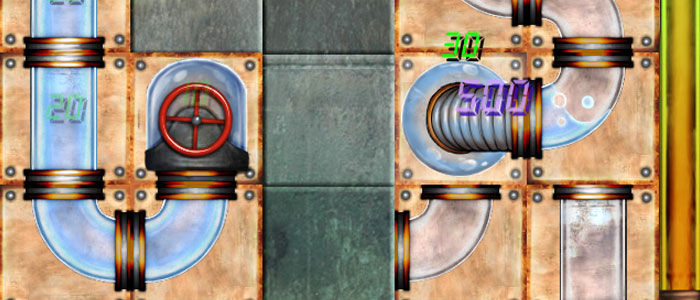[tab:Review]
Pipe Drop is an interesting twist on the puzzle formula made popular by Tetris more than 25 years ago. The game is simple enough to understand for anyone who has played a drop block game. As segments of pipe fall, they can be grabbed with a finger press and moved around the board in any direction. Pipe pieces can be rotated by tapping, even after the dropping movement is complete. This allows strategic chains of longer pipe.
In order to clear blocks, a spigot is required. Once the faucet is in place, and your pipe segments are lined up properly, press and hold to trigger a flow of water through the length of tubing. Unlike Pipe Dream (or Bioshock’s hacking minigame), no specific outlet for the flow is required. If a pipe was configured to allow water to pass, it clears. The longer the pipe, the more points awarded.


This also fills up the special meter on the right side of the screen. When this tops off, a special block becomes available. By default, this is a bomb that, when dropped and triggered, clears blocks in the immediate vicinity. Fill the meter up twice, though, and the sparks really fly with an explosion that clears the entire board.
Different specials can be unlocked by accomplishing feats in-game: complete a pipe of over 20 segments, reach level 20, or earn a 5x multiplier. These include spigots that eject water in multiple directions, teleport blocks, etc. Each changes the strategy a bit, but none alter the fundamental nature of the game too significantly. These new specials are the only achievements you will find as Pipe Drop does not support OpenFeint or GameCenter.
The tutorial covers the basics, but there are a number of items that are left up to the player to figure out. For instance, only through experimentation did I figure out that multipliers are earned by using branching pipes. This leads me to one criticism of the game: too much is left up to trial and error. As new elements are introduced, the game should pause for a quick introduction of the new mechanics. This includes pieces with metal bracing, different spigot types with meters, etc. These could just be changes in the art style, but that is never made clear, especially since these new segment types coexist with those appearing at the outset.
Another major criticism is that, unlike many other drop block games, the next piece is on a countdown timer. At later levels, multiple blocks will be dropping simultaneously as you manipulate pieces. Once you hit level 25 or so, strategy takes a back seat to speed, especially since spigots become quite rare. I expect that the reason for multiple pieces is to prevent the player from infinitely suspending a piece to consider the perfect move. However, with the dearth of spigots and the introduction of immovable and impenetrable block, the challenge ramps up too quickly, eliminating all opportunity for planning.


I did enjoy both the visuals and the audio. The graphics have a vibrant, hand-animated look to them and, in order to keep things fresh, change throughout the game. At level 20, a volcano appears, the colors take on a reddish hue, and the pipes begin to carry lava instead of water. The music changes to match, bringing a new sense of urgency.
Pipe Drop is an enjoyable twist on two tried and true formulas. At $.99 in the App Store, it’s easy to recommend for fans of either. Just be forewarned that the tutorial only covers the basics, with no explanation of higher-level mechanics.
Review copy provided by publisher.
[tab:Screenshots]
[tab:END]
